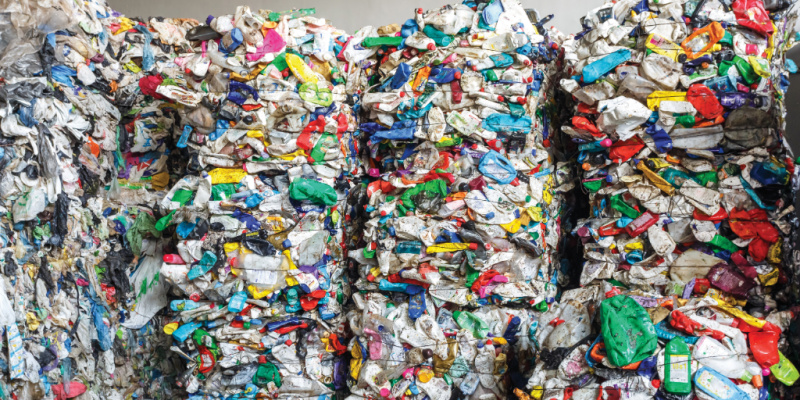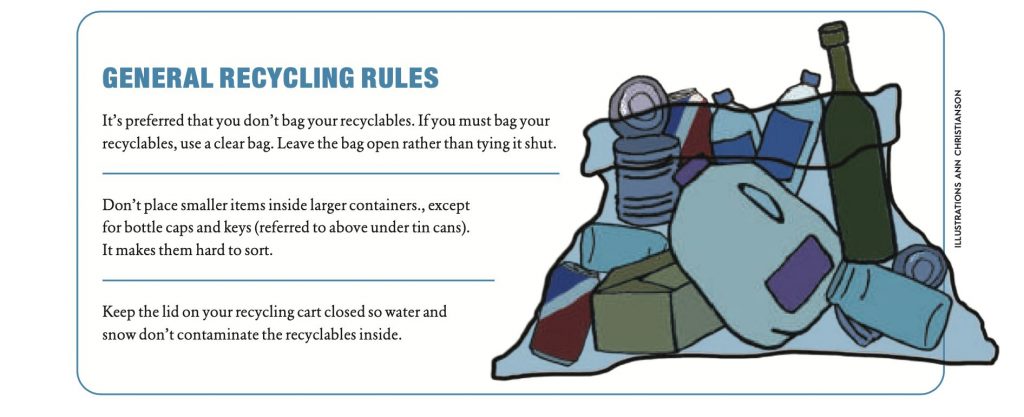By Holly Marley-Henschen
Recycling is one of those non-controversial issues that we can all agree is a good idea — like donating to a great cause and buying local. As wonderful it is, recycling has its nuances. What remains elusive to many is which items can actually be recycled, particularly be- cause recycling standards vary from city to city. For example, Madison accepts all-metal pots and pans, but Verona does not.
Wanting to recycle as many things as possible makes sense. Recycling extends the life of our household waste and may reduce our impact on the environment. At the same time, recycling can be complicated. Recycling guidelines at your workplace can be different than residential curbside standards.
Before digging into recycling, it’s important to remember that reducing and reusing can be an important precursor to recycling. Ideally, creating as little waste as possible is the gold standard. That way, we’re using fewer resources to begin with. However, this isn’t always realistic in everyday life, so recycling is our second-best option.
To get the (not so) basics on recycling, we turned to Danielle Pellitteri, vice president of Pellitteri Waste Systems, a family-owned waste management business that’s operated in Madison since the 1940s. Pellitteri Waste Systems accepts curbside recycled materials from nearly 51,000 homes in Madison, Fitchburg, Sun Prairie, Waunakee and 25 other municipalities that are processed at their Kipp Street Materials Recovery Facility on the far east side of Madison.
For starters, Pellitteri says to look for packaging while shopping that’s more likely to be recycled. She recommends avoiding plastic packaging when possible. “Steel, aluminum, glass and cardboard are more recyclable than plastic,” she explains.
Buying products packaged in plastic is often unavoidable, though, and can be tricky, because there are so many different kinds, Pellitteri says. The most recyclable plastics are #1 and #2, particularly in the form of bottles and containers with lids. Plastics #3 through #7 are more difficult to re- cycle, though Pellitteri Waste Systems accepts them. Unnumbered plastic packaging and film that is placed in curbside recycling bins probably won’t be recycled, she says.
Remember when we said recycling was nuanced? Though we may think we know what’s recyclable, there’s one issue that Pellitteri Waste Systems encounters on a regular basis. It’s called “wishcycling,” also known as “aspirational recycling.” And it’s been on the rise in recent years.
“Wishcycling is when you put something in your recycling bin that you hope is recyclable and think should be recyclable, but are not sure if it is,” Pellitteri says. About 20% of the recycling that comes through their facility ends up in the landfill, because it’s actually not recyclable. For perspective, 97 million pounds of mixed recyclables were sorted by Pellitteri Waste Systems in 2019.
“‘When in doubt, throw it out’ is a common slogan in many communities across the country to try to combat wishcycling,” Pellitteri says. Recycling the right way keeps operations running smoothly, avoiding hazardous circumstances for workers. For in- stance, sparks from electronics can cause a fire, or a loose plastic bag can gum up machinery, causing machine shutdowns.
In general, when it comes to recycling rules, trust your local municipality’s information first.
“People will see national stories about recycling and think they apply to where they live. They do not. It’s a regional thing,” says Bryan Johnson, the City of Madison’s recycling coordinator. “We have really strong recycling mandates in Wisconsin that aren’t available in other states.”
THE JOURNEY OF LOCAL RECYCLABLES
- If you live in Madison, Fitchburg, Waunakee, Sun Prairie or the 25 other municipalities Pellitteri serves, the sight of their garbage and recycling trucks is probably a familiar sight. But, our garbage and recycling doesn’t just disappear once it’s tossed in a bin and picked up by a these giant trucks.
- When recyclables arrive at Pellitteri’s Kipp Street facility, the trucks un- load material on to the tipping floor. Workers in front-loaders scoop up recy- clables and load it into metering bins, which sorts the material initially and keeps the sorting equipment function- ing properly, with a constant stream of recyclables.
- Recyclables go up a conveyor belt and arrive at the presort station. Quality control workers remove unacceptable materials, like greasy pizza boxes and bags of garbage, at checks throughout the line. Materials continue to move through a single-stream system that carries the waste on a series of conveyor belts. Different materials are sorted by several methods. Waste runs over discs designed to let everything besides cardboard and paper fall through. To sort some plastics, the system shines rays of light at objects and reads how it’s reflected back. Other materials are hit with a shot of air that knocks them toward their appropriate sort- ing lines. Robotic arms use artificial intelligence to remove other types of plastic. Specialized magnets remove tin and aluminum.
- The sorted materials are stored in bunkers until they’re compacted into large bales and sent to end users. Interestingly, much of the recycled goods from the greater Madison area stays in the region. Paper is shipped to paper mills in Wisconsin or Indiana to be made into tissue paper. Cardboard goes to Indiana to be reshaped into card- board boxes. No. 1 plastic water bottles are sent throughout the Midwest and made into new water bottles, carpet or clothing. Other plastics are made into new plastic products, such as lawn edging, drainage tile and plastic containers. Metals, including aluminum, steel and tin, are melted down at local facilities and made into new metal products. Glass goes to another facility to be sorted by color and used to make new glass bottles.
Recycling does make a difference, which is why it’s helpful to be as in- formed as possible so we can all do our part to make the processing of our recyclables smoother when they leave our homes, bound for the recycling facility.
“It is important to know what your specific recycling collector allows, as each sorting facility has specific materials they do and don’t accept,” Pellitteri says. “Additionally, the proper preparation of accepted recyclables can also vary.”
The information in this article pertains to curbside recycling for the 29 municipalities Pellitteri serves, including Madison, Fitchburg, Sun Prairie and Waunakee. Multi-family buildings that have shared waste receptacles may be collected by different companies with different standards. Often, there is a sticker with the basics of recycling rules on the receptacle. For more in- formation, check the website of the company whose label is on the receptacle. For instance, Waste Management has a recycling guide (wm.com) as does Advanced Disposal (advanceddisposal.com).
Recycle Like a Pro!
Recycling items the right way is as crucial as the act itself. Soda bottles that aren’t empty and food containers that still have residue will be sent to the landfill, which is part of what led to China’s 2018 announcement that they would no longer purchase certain mixed paper and plastic recycling from the U.S., creating a conundrum for many facilities that relied on that market.
But don’t worry, this how-to guide will help make the process much more clear and straightforward.





